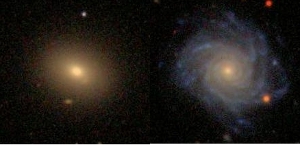|
|  |
The fraction of available baryons locked up in stars in galaxies such
as our own Milky Way is only around 20 percent. Simple physical
considerations predict that most of these baryons should cool, accrete
and form stars. Up to the present day, the galaxies accrete additional
material in the form of gas from the external environment as some
observational evidence shows. In particular, neutral hydrogen (HI)
cloud complexes, HI-rich dwarfs in the vicinity of spiral galaxies,
extended and warped outer layers of HI in spiral galaxies, and
lopsided galaxy disks have all been cited as evidence for on-going gas
accretion in nearby spiral galaxies. However, the total amount of gas
accreting in this way is much too low to sustain star formation at the
observed rates of 2-3 solar masses per year in these
spirals. Astronomers have attempted to look for gas accretion in other
forms, e.g. in an extended, hot gaseous corona surrounding the galaxy,
in the form of ionized gas at intermediate temperatures, or in tiny
clouds of neutral gas (where a ”tiny“ cloud for
astronomers has a mere one thousand to one hundred thousand solar
masses). But in spite of these on-going searches, conclusive evidence
for gas accretion remains elusive.
If we cannot observe gas accretion directly, can we at least hope to
observe its effects? Semi-analytical models for the formation of disk
galaxies, their chemical evolution and star formation are commonly
based on the ”inside-out“ picture in the context of Cold Dark Matter
cosmologies. In this scheme, gas in the dark matter halo surrounding
the galaxy cools, falls onto the galaxy, and fuels star formation in
the disk. As the gas conserves its angular momentum and gas accreted
at late times has a higher specific angular momentum, it settles in
the outer regions of the galaxy. In this picture, galaxies with
recently acquired gas from their halo therefore should have not only
unusually high gas mass fractions but also young, star-forming outer
disks.
To test this picture, the MPA scientists performed a statistical study
of the colours, star formation rate and neutral hydrogen (HI) gas
fractions in galaxies. The sample of HI-rich, nearby galaxies (see
Fig. 1) was selected based on a combination of data from the Arecibo
Legacy Fast ALFA survey (ALFALFA) and the GALEX Arecibo SDSS Survey
(GASS).
Galaxies with more gas are in general bluer and show more active star
formation. The new study now showed that an increasing HI content also
leads to a colour gradient across the galaxy disk: Galaxies with
larger HI fractions have bluer, more actively star-forming outer disks
compared to their inner parts (see Fig. 2). This means that the outer
regions of HI-rich galaxies are younger. HI-rich galaxies also appear
larger in blue light than in red light.
These results are indeed consistent with the ”inside-out“ picture of
disk galaxy formation. They furthermore provide indirect evidence for
the idea that disk galaxies continue to grow through gas accretion in
the local Universe. The study also showed that there is no intrinsic
correlation between the HI fraction and the measured asymmetry of the
optical light of the galaxy. This suggests that the gas was most
likely accreted smoothly and not in discrete units (see Fig. 3).
Jing Wang, Guinevere Kauffmann, Roderik Overzier and Barbara Catinella
Further reading
Wang, J., Kauffmann, G., Overzier, R., Catinella, B. et al.,
"The GALEX Arecibo SDSS survey: III Evidence for the Inside-out Formation of Galactic Disks",
2011, MNRAS, 412, 1081
 (http://adsabs.harvard.edu/abs/2011MNRAS.412.1081W) (http://adsabs.harvard.edu/abs/2011MNRAS.412.1081W)
|




